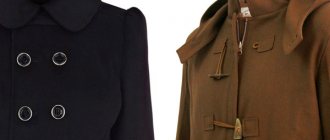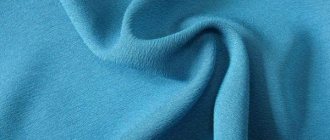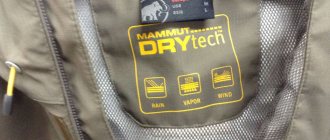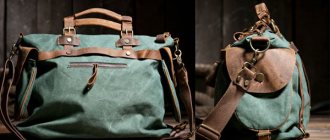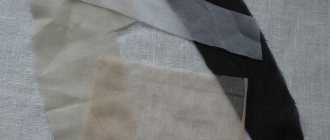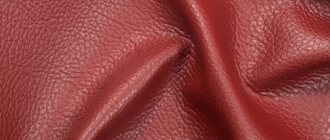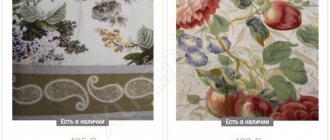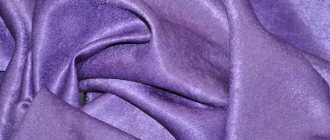What type of fabric is this
Polyester fabrics are synthetic materials made from polyester (PE) fibers. Polyesters occur naturally. Wood resins, amber are natural polyesters. Synthetic species are a broad class of polymers obtained by synthesis from polybasic acids and polyhydric alcohols.
Polyester fabric colors
PEF fibers are made at textile factories from melts of synthetic polyesters - polyethylene terephthalate and its derivatives. On spinning machines, the molten raw material is forced through the holes of the spinnerets. The flowing streams harden in the cold air, forming fine fibers. The primary threads are drawn, heat set and finished.
Polyester fabrics are made from yarn on weaving machines. Other chemical and natural fibers are often added to polyesters. They produce dense shiny or matte materials that are similar to silk, wool, and cotton.
Varieties of polyester suitable for sewing curtains
Based on polyester fiber, manufacturers produce types of fabrics that differ in their properties. Only a few of them are suitable for sewing curtains and curtains.
- Lavsan is a type of polyester. Ideal for making home textiles as it can be easily dyed to any color. Lavsan does not fade in the sun, is durable and easy to maintain. Even after a long period of use, the fabric does not lose its attractive appearance.
- Acrylic. This is a very dense fabric, which is suitable only for making roller blinds. A big plus of acrylic is its unpretentiousness to operating conditions.
- Polyester silk . This is a thin material that is difficult to distinguish from natural silk fabric. It is just as light and smooth, and shimmers just as beautifully in the sun. Very beautiful curtains are made from polyester silk that look very attractive.
Origin story
Synthetic polyester fibers have been produced since the mid-20th century. Trade names of fibers and fabrics made from them are polyester, terylene, dacron, lavsan.
Polyester
Popular synthetic fabric polyester: what is known about its characteristics and areas of application?
more details
Lavsan
Oil fabric lavsan: what is known about it? What are its characteristics?
more details
In England, pilot production of terylene appeared in the late 1940s, industrial production - a few years later. Dacron was released in the USA in 1953.
In the laboratory of the USSR Academy of Sciences, lavsan was synthesized in the late 1940s. The Kurskkhimvolokno chemical enterprise has been producing lavsan in industrial quantities since 1960.
Rules for washing and ironing
The unpretentious material will last a long time if you follow proven recommendations:
- study the label. The manufacturer specifies the cleaning conditions;
- It is permissible to use the products in any physical state (powders, gels, solutions, capsules). Dry mixtures should first be diluted in water;
- adhere to a temperature regime no higher than 40°;
- When cleaning items in the washing machine, set to the delicate cycle. Number of revolutions up to 800;
- be sure to add conditioners and softeners. Factory hardness is enhanced without the use of special means;
- In case of strong, stubborn stains, dry cleaning is possible.
It is not necessary to iron polyester items. Takes its original shape without additional manipulation. If ironing is unavoidable, iron only from the wrong side through a damp cloth (gauze). Set the iron to “silk” mode. This will prevent sticking to the surface.
Fabric composition and its properties
The materials consist of synthetic PEF fibers. Fabrics are produced with the addition of other fibers. An example of a composition is polyester with the addition of elastane.
Properties:
Do not collapse due to temperature changes.
Difficult to light. Once the source of ignition is removed, they go out.
Resistant to light and oxygen.
Do not absorb water (except microfiber).
Resistant to moths, mold, microorganisms.
They retain their shape well and do not wrinkle.
Resistant to hydrogen peroxide and not destroyed in organic solvents.
Elastic, with low thermal conductivity.
Durable, abrasion resistant.
Advantages and disadvantages
Polyester fabric is endowed with a number of positive features:
- strength. The canvas can withstand significant loads and is resistant to mechanical damage. It will take a lot of effort to break;
- long service life while maintaining original quality indicators;
- light weight. Lightness adds comfort while wearing;
- does not cause allergic reactions. Suitable for people with sensitive sense of smell;
- ease of care;
- variety of shapes and colors.
For information! The list of characteristics varies depending on the quantity and composition of accompanying raw materials.
Along with the advantages, there are several disadvantages that can overshadow the impression of the fabric:
- without the use of an antistatic agent, most varieties become highly electrified;
- not recommended for use in hot weather. Despite the air exchange, they practically do not allow oxygen to pass through. In warm weather, wearing things becomes uncomfortable;
- increased rigidity. This drawback is eliminated by the use of balms and conditioners during the washing process;
- combination with natural fibers affects the price. The cost of such products is an order of magnitude higher than pure synthetics.
Important! When cleaning canvases, avoid adding chlorine-containing solutions. Despite its resistance to aggressive environments, chlorine washes out the color and negatively affects the strength of the weaving.
Types of fabric
By production method:
- Non-woven fabrics. Rolled canvases, bonded by needlepunch or thermal methods. Durable, elastic. Suitable for construction, repair, insulation.
- Woven fabrics.
- Knitwear. Knitted from yarn made from PEF staple fibers.
Polyester fabrics:
Polyester, lavsan
Crinkle-resistant, heat-resistant, rigid, do not allow water to pass through.
Made from acrylic fibers
Dense, waterproof, steam permeable
Microfiber
Fibers with a diameter of several microns. Soft, absorb water well.
Polyester silk
Lightweight but durable. Often treated with protective compounds.
Properties of polyester/polyester
The material belongs to synthetic fabrics, but its characteristics are not much inferior to natural materials. The raw materials for polyester are petroleum products, but few people know about it. Whether polyester fibers are harmful to human health or not has not yet been proven, however, if a serious danger existed, it would not be used on such a scale for production.
Features of polyester
- The first thing I would like to say about this fabric is that it practically does not wrinkle and holds its shape well.
- Prolonged exposure to high temperatures can cause wrinkles to form, which are then difficult to remove.
- Polyester dries quickly.
- Does not stretch after washing.
- It wears for a long time without losing its appearance.
Disadvantages include the ability of synthetic material to become electrified, but scientists are trying to solve this problem. How to care for things made of polyester fibers?
In general, polyester is low maintenance. Most material is afraid of high temperatures and, if we are talking about washing, then the spin mode. If you adhere to the following recommendations, clothing or other polyester products will last you a long time.
- Both hand and machine wash possible.
- Before washing, carefully read the product tag for care instructions.
- The optimal temperature regime for polyester is +300C+400C, but some fibers feel good at temperatures of +600C. If the water temperature is too high, the product may become severely wrinkled.
- Use a delicate wash cycle, do not spin.
- Do not bleach polyester items, and never boil them.
- Do not use drying chambers or allow polyester to come into direct contact with a radiator or other heat sources. If you want to dry the item in the fresh air, then avoid direct sunlight.
- You can iron the fabric only through gauze, and the iron should be set to the minimum temperature setting.
Pros and cons of fabric
Advantages of materials:
- resistant to light and temperature changes;
- non-flammable, chemically resistant;
- resistant to mold, moths;
- durable, resistant to bending and abrasion;
- do not wrinkle, keep their shape;
- with low hygroscopicity (a plus for protective coatings);
- thermoplastic, retain the pleated effect;
- lightly soiled, easy to clean;
- easy to wash, dry quickly;
- low prices.
Flaws:
- low hygroscopicity;
- poor hygienic properties;
- become electrified;
- pellets form;
- hard;
- Polyester doesn't dye well.
To eliminate the shortcomings, PEF yarn is combined with elastane, viscose, cotton, silk, and wool.
How does polyester combine with other fibers?
Different percentages of mixed components form new varieties of fabrics with completely different characteristics. Polyester in its pure form has some rigidity, which it brings to the quality of composite materials.
What does mixing fibers do:
- extending the life of the product;
- simplifying fabric care processes;
- indicators of creasing and shrinkage are reduced;
- cheaper finished products at the expense of raw materials.
A popular combination is mixing polyester with cotton, linen, wool, polyamide, and viscose. The share of synthetics will range from 30 to 70%, sometimes up to 100%. Combining polyester with natural fibers allows you to maintain the hygienic characteristics of the material.
Polyester
With wool
Wool items with added polyester last longer. Increases resistance to abrasion and machine wash on delicate cycle. When the proportion of synthetic fibers in a woolen product is less than 30%, the product does not lose the external qualities inherent in pure wool.
Polyester combination
With flax
A soft fabric combining polyester fiber with linen is used for sewing light dresses, summer and sportswear, and blouses.
Combined polyester
With clap
What is cotton polyester fabric composition? Durable material with improved characteristics of cotton fiber, which is subject to shrinkage and deformation, is used to the maximum when sewing bedding, tablecloths, and lambrequins. Bright rich colors retain their original shade for a long time, thanks to the presence of polyester in the composition.
Important! Cotton polyester fabric is used in making clothing
Tablecloth
With spandex
The combination of polyester and elastane is used in the production of hosiery, accessories in the form of gloves, and sportswear. In combination with spandex, the elasticity of the material increases. The product stretches and fits the body comfortably, is breathable and has hygienic qualities. Popular products include sports tops, tights, tank tops, corsets, breeches and leggings for athletes.
Corset
What standards are used in production? What do they take into account?
GOST standards apply for polyester materials:
- 26095-84 - for technical fabrics;
- 25076-81 - for vehicle finishing;
- 29223-91 - for dresses, dresses and suits made of chemical fibers.
State standards set standards for:
- raw materials, dyes;
- physical and mechanical characteristics;
- color fastness;
- deviations in width, surface density;
- grades;
- labeling, packaging;
- test methods, acceptance;
- transportation, storage.
Features of polyester and polyester fibers
This product has many advantages, but there are also disadvantages. First, about the advantages of the material and products made from it:
- practically does not wrinkle, so does not need ironing;
- things dry quickly;
- after washing, the material does not lose its shape (does not stretch, does not shrink);
- The clothes are practical to wear and retain their original appearance for a long time.
Flaws:
- under the influence of high temperatures, wrinkles may form on things that are difficult to smooth out;
- High electrostaticity, but this can be eliminated with an antistatic spray.
Polyesters are also polymer fibers, the peak of their popularity occurred in the 90s of the last century. At that time, sports suits and clothes for discos were made from polyester fabrics.
What is the reason for the high popularity of the material?
The unique chemical properties that polyester fiber possesses translate into the excellent physical properties of polyester fabric. Chemical fiber derivatives produce a variety of materials, ranging from faux fur to insulation and tire reinforcement.
Polyester color range
Polyester fabric is quite heat-resistant, unlike most synthetics. High strength and wear resistance. The fire safety and water resistance of the fabric is used in the manufacture of certain types of workwear for enterprises.
The ability to retain shape is used in the manufacture of certain types of products, such as pleated or pleated skirts. Fade resistance is used in the production of banners and flags.
Polyester fabric
What do the numbers in the name of the roofing material mean?
Many people mistakenly believe that the numbers in the name of the roofing material (for example, Gidroizol HKP-4.0) indicate the thickness of the material. This is wrong! Almost none of the manufacturers of rolled roofing materials standardize the thickness.
These numbers indicate the weight, that is, the weight of the bitumen binder in kilograms per 1 m² of base. Accordingly, the material Gidroizol HKP-4.0 has a bitumen binder weight of 4 kilograms per 1 m² of base. Based on this, it is very easy to calculate the weight of one roll. Considering the roll area is 10 m², one roll of Gidroizol HKP-4.0 weighs 40 kilograms.
A little trick: if you subtract 0.7-0.8 from the weight figure, you can also get the thickness of the material. The approximate thickness of Gidroizol HKP-4.0 is 3.2-3.3 mm.
Which fabric is best to choose for making a particular material?
Polyester is good to use for floor coverings and carpets, as it has wool fabric. But this does not preclude its use with other fibers for the manufacture of household goods: sofa upholstery, covers, strollers and more. Other polyesters are good for use in clothing, outdoor accessories, and in the automotive industry for tire reinforcement. There are also faux fur products based on this material.
People prone to allergic reactions should be careful when handling products, because if processed poorly and poorly, the material can cause allergies. When purchasing, you should carefully choose the material and be confident in the quality of the purchased product. You need to make sure several times that there really are real polyester fibers.
ProductsComment
Customer Reviews
The overall rating for polyester is high.
Buyers emphasize the good performance of items containing this fiber: they do not shrink, do not fade, do not pill, and protect from moisture.
Disadvantages include poor breathability.
Polymers appeared in everyday life with the development of the chemical industry. Plastic products have filled all areas of human activity. Polyester fibers began to be used for the production of fabrics. High-quality material has quietly entered the knitwear market.
